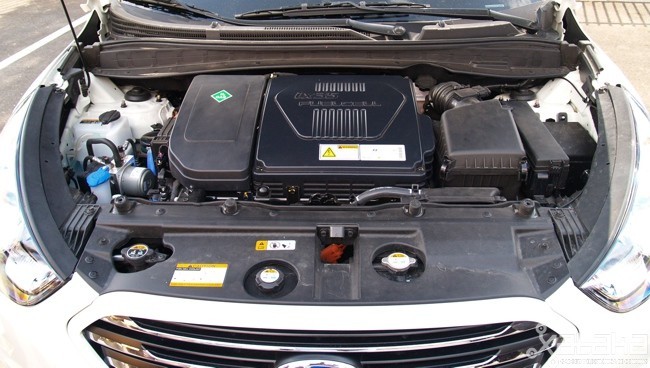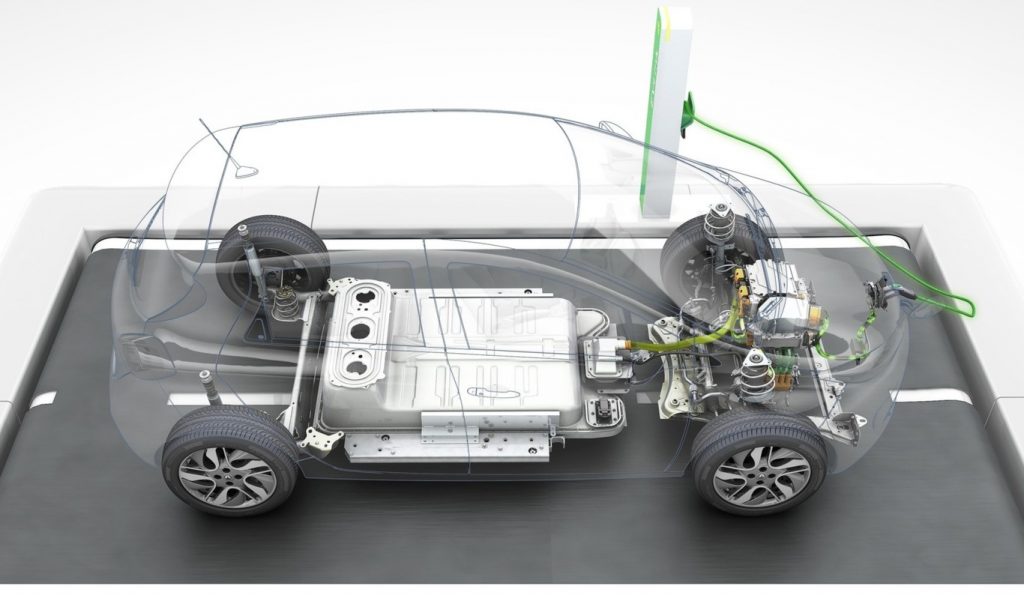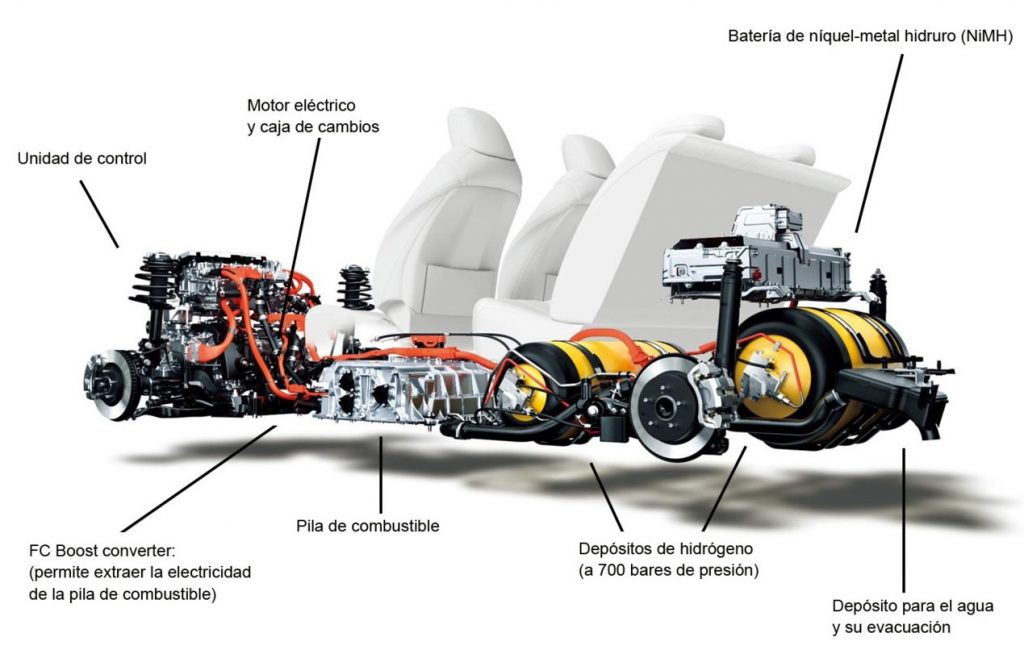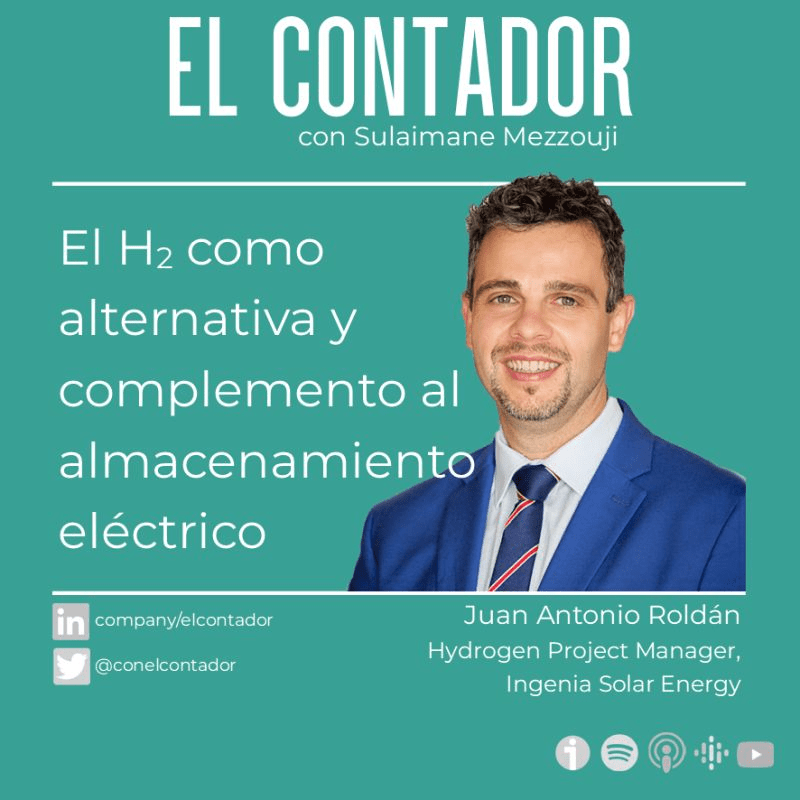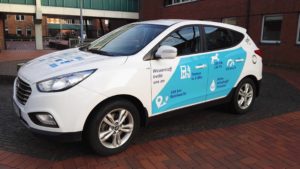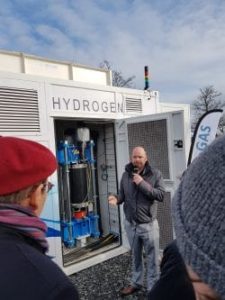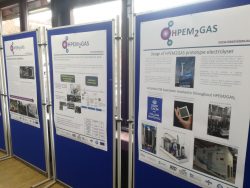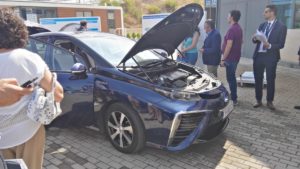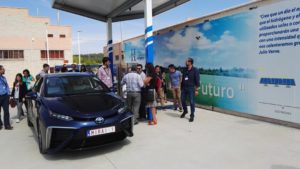The hydrogen car in Spain and Europe
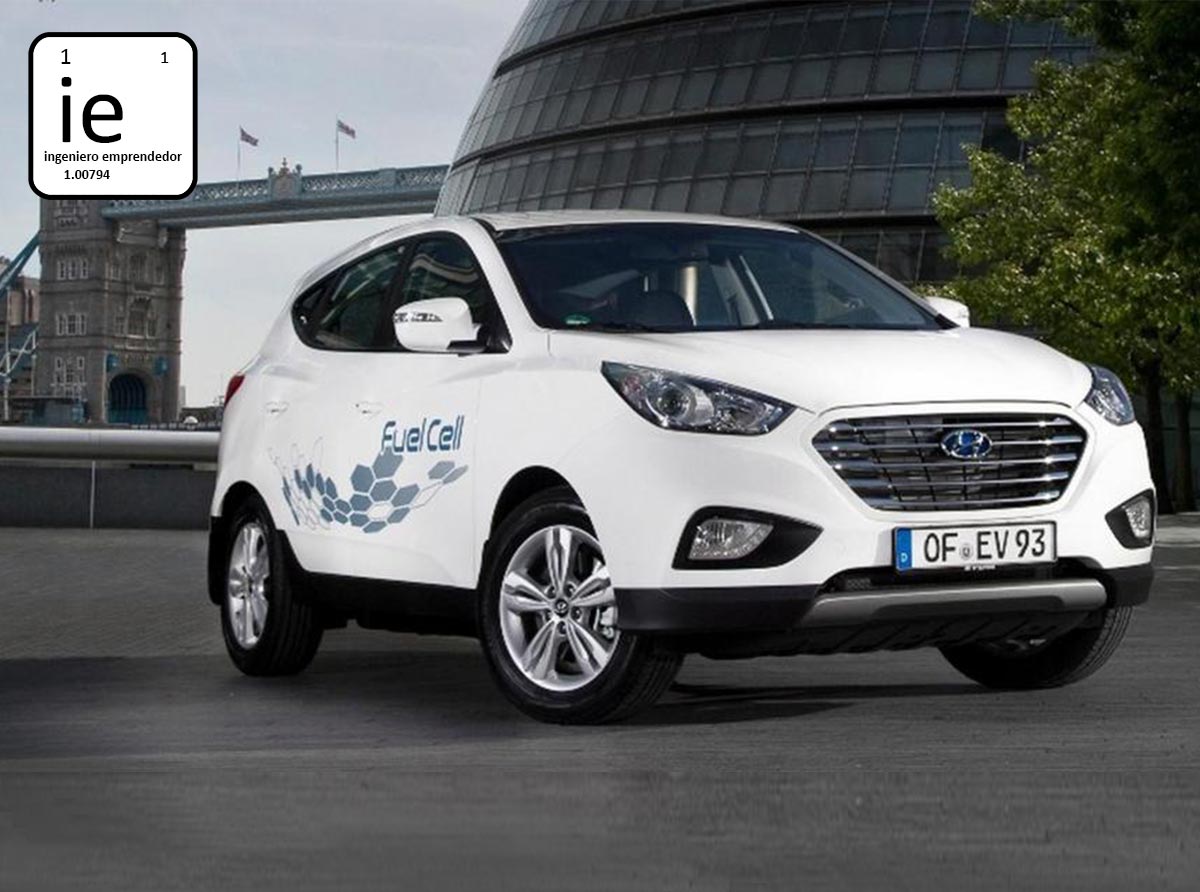
Hyundai to sell its first hydrogen car in Spain in 2018:
The news I bring you this week is that Hyundai is preparing to sell its first hydrogen car in Spain. It will be between late this year and early 2018. The Korean manufacturer finishes a new version with a slightly lower price than the current one and that could be placed in the environment of 50,000 euros per unit, a price that I hope it goes down. The company has confirmed that the first cars to be sold in Spain will go to a corporate client.
The vehicle began to be manufactured as a prototype in the year 2000 and has been commercialized in Europe since 2015, today there are already delivered 300 vehicles in Europe in 16 different countries. This fact is great news for the defenders of hydrogen.
The Hyundai ix35 Fuel Cell in depth:
If you do not know, it was the first hydrogen-powered vehicle to be produced in series and put on sale in Europe in 13 different countries and is equipped with a 136 hp electric motor, which allows it to reach a top speed of 160 km / H. Source: El confidencial.
Regarding emissions, it should be noted that it does not produce harmful emissions during driving, only water vapor from the exhaust pipe.
If we think of autonomy, with a single hydrogen reservoir can realize 600 kilometers, offering practically the same benefits as a car with conventional combustion engine, so it is ideal not only to move within the city, but also to travel long.
.
Collaboration Agreements:
Hyundai Motor Group has the vision of becoming the leading car manufacturer in environmentally friendly vehicles in 2020. That is why in 2014 it launched the 2020.22.2 project where it set the goal of creating 22 low emission models for the Year 2020, including 12 hybrids, six plug-in hybrids, two electric vehicles and two hydrogen fuel cell electric vehicles.
As you will be assuming the Korean brand has signed various collaboration agreements with scientific entities around the world for the implementation of this technology in the near future. Among them, with the “Fuel Cell Hydrogen Joint Undertaking (FCH-JU)” and with “Hydrogen For Innovative Vehicles (HyFIVE)”.
The project for Europe is related to the fuel cell and will help increase the hydrogen refueling infrastructure, which will make the technology more accessible to drivers across Europe.
Project for Hydrogen Vehicle Innovation (HyFIVE):
The ix35 Fuel Cell deployed are partially funded by the HyFIVE Project. The HyFIVE project is funded by the Joint Fuel Cell and Hydrogen Company (EC FCH), a public and private partnership that supports research, technological development and demonstration (RTD) in hydrogen fuel cell and energy technologies in Europe. Fuente: Hyundai news.
Toyota is not far behind:
All lovers of cars like me, at this point you will be thinking And what do the other brands? Because in this section I am going to talk about Toyota that is one of the pioneering brands in hydrogen research.
Maybe you know the vehicles Toyota Mirai, These are only manufactured in a plant and it is not the most robotized of the ones they have according to a representative of the company. In 2015, only 700 units were produced, but they expect production to increase to 5,000 next year. Despite its lack of implementation, the demand for this type of vehicle is enormous. In fact, Toyota maintains a six-month waiting list for delivery.
What data do we have about pollution:
A very important fact is that cars that use hydrogen as fuel work with two different methods: with combustion or through a pile. In the second case, automobiles are zero emissions and only expel steam or liquid water. The tanks usually store up to about five kilos of hydrogen that feed the pile. This receives air and with an inverse electrolysis mechanism is able to generate the energy to move the motor.
Although there is some fear among consumers, manufacturers assert that hydrogen tanks are safe and the possibility that they explode or leak is minimal.
Let’s focus for a moment on the internal circuit that makes hydrogen, it is completely isolated from the interior of the car, although the vehicles have detectors that trigger the alarm if they detect a leak. After two decades of testing, manufacturers have proven that the durability of the vehicle is much higher than that of conventional. Source: Economía Digital.
Production of hydrogen from fossil fuels:
Now I am going to tell you something that should disturb us all and that we must keep in mind when it comes to supporting this technology. There is a dark side to hydrogen: Hydrogen is currently produced massively from fossil fuels through some engineering processes such as the reforming of natural gas, a process that generates a lot of CO2.
Although at first glance this can be a great obstacle to consider this technology as clean, this is not really the case, because the transition to a CO2-free economy must be done gradually and the positive impact of these vehicles is much greater than the negative .
If we base the generation of hydrogen fossil fuels the carbon dioxide that does not emit the exhaust pipe escapes through the chimneys of the hydropower plants, responsible for 95% of the world production of hydrogen. That is why it is very important to analyze the life cycle of the product, and not only focus on its use.
That is why I support that hydrogen must come from those of renewable raw materials, in particular I think it must be produced from water, by electrolysis.
Electric vehicles, whether battery-powered or fuel-efficient, are a good or bad choice for improving air quality depending on whether electricity comes from coal or from renewable energy. Source: El Confidencial.
Hydrogen versus electric:
Perhaps with the previous reflection I have made you think if it is better to have a car purely electric or to run with hydrogen, so to help you decide I propose this duel.
Let me start by giving a brief description of these two adversaries:
- – An electric car, sometimes also called “electric only” car, “100% electric” car, or Battery Electric Vehicle (BEV), is a car in which the wheels are driven by An electric motor that obtains the necessary energy from an accumulator that stores it, usually a battery, but could also be a capacitor, and which can be recharged again and again by connecting the vehicle to a conventional or specific electrical outlet, or Through wireless recharge.
- – An electric hydrogen fuel cell car, or FCEV, stands for Fuel Cell Electric Vehicle, is a car in which the wheels are also driven by an electric motor that obtains the necessary energy from an accumulator not too large (Usually also a battery), and a fuel cell powered by hydrogen, which, when combined with oxygen taken from the air, generates electrical energy on board the car that is transferred to the engine or battery, as the case may be. In principle this type of car is not plug-in, although technologically it is possible and there are variants that they are.
Now I will tell you a number of advantages and disadvantages of these vehicles so that you can make a decision of your own:
Advantages of electric car:
-
– Lower price:
Currently an electric car is cheaper than a car with a hydrogen battery. If we do not have any type of aid or subsidies, we can find them in Spain for 29,235 euros, with battery in property and the most economic version (this is the official price “rate” with taxes included, in this point it is necessary to mention that The government of Spain has plans to help with the purchase of these cars.
-
– Greater efficiency:
The car with hydrogen battery is in full development therefore the electric car is more efficient at present than a car fuel cell and a car with internal combustion engine. This we can affirm because the energy consumption homologated to cover 100 km is smaller in an electric car.
I will now consider global consumption, which in a combustion car is considered from the tank to the wheels, I do this so that we all understand that the total energy actually spent by a car is greater than that which is strictly spent running The car, for the electric car, considering losses in generation, transport, distribution, recharge and battery, we go to about 30 kWh / 100 km. In a gasoline car is almost double around 60 kWh / 100 km.
-
– Lower global emissions:
It must be clear to us that the operation of the electric car or the hydrogen-powered car does not generate pollutant emissions locally, that is, they do not pollute the air wherever they circulate. However at the global level, ie, considering the generation of electric energy, or the production of hydrogen, they do generate emissions if they come from fossil fuels. Emissions are lower the lower energy consumption the vehicle has.
Let me explain: the emissions generated depend on the type of energy source that has been used to generate electricity or hydrogen, since each has a corresponding emission factor. Generating electricity with coal makes no sense at the ecological level and can cause these cars to generate more emissions even than a car with internal combustion engine, and instead if the electricity is generated by renewable sources their emissions are noticeably smaller. In Spain the electric car, of any kind, makes sense since renewable energy accounts for about 40% of the electricity generated.
When talking about the global emissions of an electric car, several manufacturers have performed in certification bodies and homologation, such as the German TÜV, life cycle analysis of their respective models, where not only the consumption of Energy and car emissions during its use, but also by the generation of electricity, and even by the manufacture and final recycling of the vehicle.
Examples of these data are the life cycle of the Renault Fluence Z.E., of BMW i3, of Volkswagen e-Golf or the Kia Soul EV. In all cases the conclusion is that the electric car generates less emissions than an equivalent car with gasoline or diesel engine. From an electric car hydrogen fuel cell, for now I have not yet seen any life cycle analysis.
-
– Cost per kilometer:
As the price of electricity varies, it is not the same to recharge during the day with a single rate to recharge at night with hourly rate, each car has a consumption, depends on the way of driving, the efficiency of the recharge can also Vary according to the circumstances, and each power company may have a slightly different price, you have to talk about an approximate price range.
Recharge at home in the supervalle time slot, an average electric car can spend between 1 and 1.50 euros per 100 km. Recharging for the day in the normal time zone the same car can spend between 2.5 and 3 euros for 100 km, simply because the price of kWh is higher (in both cases, including taxes). Recharging on the street is more expensive, so unless need is not recommended.
-
– Greater power:
For now it is easier to build electric cars with a lot of power, than in the case of electric cars fuel cell. Serve as sample the Tesla Model S, whose most powerful version has 539 hp (this figure is lower than the 772 hp that would result from adding the power of the front engine and the rear, as it is limited by the voltage and capacity of the battery).
We talk about cars that are made in series and that circulates in the streets. In a hydrogen fuel cell car, as we will see a little later, manufacturers move in smaller powers but this is rapidly changing.
-
– Simpler infrastructure:
I suppose that the infrastructure of points of recharge in zones of public use has been growing little by little, if we attend its quality and to that it is operative, the reality is that in countries like Spain is still reduced. However, even if this is so, in order to use an electric car, it is sufficient to have a conventional schuko type outlet and 16 A on hand to plug in the car.
As the future can not always be predicted, we can install an approved charging point in the garage for a relatively small investment of between 1,000 and 1,600 euros, with all the guarantees to recharge the car.
Disadvantages of electric car:
– The autonomy is smaller:
With a few exceptions like the Tesla Model S with 90 kWh battery que homologa en Europa 557 km, Currently the homologated autonomy of the electric cars of average type that try to have a relatively affordable price, moves in general terms between 160 and 300 km.
As you are imagining this range is less than that of a conventional car of internal combustion engine, and less than the homologated autonomy of the electric cars of hydrogen fuel cell. The new ones BMW i3 and Volkswagen e-Golf which will arrive after summer have seen increase their autonomy to 300 km, and in one or two years will arrive new models with autonomy over 400 km, among others as the Chevrolet Bolt or the Tesla Model 3.
-
– More recharge time needed:
If we heed the recommendations and recharge at home, depending on the capacity of the electric car battery, installation and recharging power, fully recharge an electric car may require between 4 and 12 hours. If we think that the car can be recharged overnight when it is parked, it does not seem such a serious problem.
For when we are away from home, at fast or super-fast recharge points, a recharge may require between 30 and 60 minutes. Although less time consuming, it is still more than it takes to refuel at a gas station or a hydrogenerate. For now there are no more options, since the rapid battery change system so promising, in practice does not exist.
I can tell you two cases of battery change projects that have not paid off: the first Better Place which were ruined because there were very few electric car models compatible with the battery change system and the second Tesla Motors because they say there is not enough demand among their customers and for now have a single station of rapid change of battery.
-
– It is necessary that the driver changes his customs:
The problem of awareness begins with having to plan the trips and stops to recharge, or meter the battery and drive more efficiently. For many, including myself, having to wait hours to recharge the car is an inconvenience that they are not willing to accept.
We are people of customs and in Spain we can refuel almost anywhere in 5 minutes in a service station. The difficulty of changing this slows many when it comes to buying an electric car.
-
– External temperatures affect autonomy:
With very low temperatures the autonomy of an electric car is considerably reduced, due to the heating of the passenger compartment, but also to the own heating of the car battery so that it has an adequate operating temperature.
Very high temperatures can also affect performance in some models, not only because the air conditioning of the passenger compartment is a significant consumption, but also because the battery cooling system also consumes energy from the battery itself, although its effect is usually less noticed than With the cold.
-
– With low battery power is reduced:
If we are not careful and plan well our trips can become low battery, in this case it should not be ignored that despite the theoretical maximum power of the car, when the state of charge of the battery is very low, the power that Can deliver to the engine is reduced.
-
– Battery life limits the car’s life:
As it is said in Chemical Engineering “everything depends on the limiting reagent” and although in recent years progress has been made in chemistry of the batteries most used today in electric cars, lithium-ion batteries, in More wear resistance due to the loading and unloading cycles and due to heat. Even so, there is no doubt that the limiting factor of the useful life of an electric car right now is the battery, which after some time will need to be changed. Manufacturers have already planned and I recommend taking into account their cost within the maintenance of the vehicle.
Advantages of hydrogen car battery:
-
– It has a greater autonomy:
In favor of the hydrogen-powered car we have its homologated autonomy is very similar to that of a conventional gasoline car, between 500 and 650 km without refueling. Do not get confused with the different homologation cycles, namely Japanese (JC-08), American (EPA) and European (NEDC), which can be understood as more or less optimistic or more or less realistic, that give different autonomies.
As I mentioned above the Hyundai ix35 FCEV homologated in Europe 594 km, and one Toyota Mirai 650 km. En These cars hydrogen is in the form of gas and that is why the autonomy depends on the pressure at which it can be compressed, the more pressure the more hydrogen.
All these kilometers of autonomy are achieved by storing hydrogen at 700 bars of pressure, this high pressure corresponds to 690 times the atmospheric pressure. If the hydrogen is introduced under less pressure, at 350 bars, the autonomy is reduced by half, and we stay with about 250 to 325 km.
A clear problem is that not all hydrogen refueling stations can compress it to 700 bar, so you have to take it into consideration.
-
– It can be refilled in 5 minutes:
The great advantage of hydrogen cars, together with their greater autonomy, is that they can be refueled very quickly with a hydrogen dispenser in a time of between 3 and 5 minutes, without involving a demand of very high installed electrical power unlike What happens in the cases of the superchargers and without reducing the life of the battery.
-
– Drivers do not have to change their customs:
I consider this to be very important because many drivers do not want to change what they have been doing all their life, do not want to have to wait to have their car recharged, or do not want to have to plan a trip with an intermediate stop wherever Enough time to recharge the battery.
This problem is more serious when they do not have a parking space where they plug an electric car, and the only option they are accustomed to is going to refuel at a service station. The idea of not having to change the current way of using and refueling cars, seduces enough drivers in favor of these cars.
-
– The external temperature does not affect the autonomy:
Engineers know that one advantage of the hydrogen-powered car is that unlike what we mentioned before with the 100% electric car, however extreme the temperatures are, there are hardly any changes in the performance of the car, nor is there a change Important in its autonomy.
Disadvantages of hydrogen car battery:
-
– High purchase price:
The first negative point of these cars is that they are quite more expensive than an electric car, although manufacturers strive to lower their price and promise that in the future they will be more affordable. There are two main culprits of these prices: the fuel cell for the rare and precious metals they use and the hydrogen tanks that withstand a very high pressure.
If you are willing to buy one of these cars, you have to know how in all markets the price depends on the manufacturer and each model. For example the Hyundai ix35 FCEV comes to cost about 125,000 euros, although the manufacturer has acknowledged that it is willing to sell it for a price lower than the cost.
In Japan, the Honda Clarity Fuel Cell has also begun to sell for about 61,000 euros to change, although there is less VAT there than in Europe, let’s not forget. In Germany the Toyota Mirai sells for about 66,000 euros plus taxes, or about 79,000 euros at the end, but it also seems that the sale price is lower than the cost, and that Toyota would be willing to lose up to 100,000 euros per unit, provided that the technology is penetrating the market.
-
– Lower efficiency:
We have to take into account that we have to produce hydrogen, compress and transport it to a refueling station, the total energy consumed globally is higher, resulting in the order of 60 kWh to 100 km in a favorable case, but even more in Worst cases, as we generate hydrogen. This is one of the challenges to overcome.
As reported by Xataka average consumption of a car like the Hyundai ix35 FCEV is 31.3 kWh / 100 km.
Even the same manufacturers as Hyundai have recognized that now the hydrogen car is less efficient than the electric car. In Toyota they comment that the efficiency of the Toyota Mirai is of the order of 50%, while that of an electric car is in the order of 70%.
-
– Higher global emissions:
If we accept that hydrogen technology needs improvement and still requires more energy both locally and globally to perform 100 km, then we have to assume that we can also generate more emissions, depending on the emissions from the hydrogen source.
Hydrogen is an energetic vector which implies that as it is not a source of energy in itself, but a carrier of the same, we need to produce it and now we consume more energy to produce it than we are then able to take advantage of it since during the Production process there are losses to be controlled.
The promise of renewable hydrogen is to change the current trend of producing it from fossil fuels in data around os 95 % of the hydrogen is produced in hydroelectric plants from fossil fuels, natural gas mainly, hydrogen can not be considered to be renewable, so our mission is to change this trend and create a hydrogen zero emissions.
-
– Cost per kilometer higher:
As long as we do not improve the technology, performing 100 km with an electric hydrogen fuel cell car will be considerably more expensive than with an electric car, and in some cases even more expensive than with a gasoline or diesel car: currently comes to cost between 8 and 10 euros the 100 km.
The costs of producing hydrogen are currently expensive because the raw material and the energy consumed are to be paid. If we want to reduce costs of raw materials, we can produce by electrolysis of the water, so that it is renewable, but results even twice as expensive as by refurbishment of natural gas. This is why new, more economical, or renewable hydrogen production methods are being researched and developed, or both at the same time.
-
– Cars with less power:
The latest models like the Toyota Mirai has a power of 154 hp, the Hyundai ix35 FCEV has 136 hp, and the new Honda FCX Clarity has 140 hp. The limitation is imposed by the hydrogen fuel cell, because the more powerful, bigger and more expensive it is. Also the fact that the battery of propulsion is small and does not have much reserve of power limits the maximum power.
We have the option of alternating a battery with a larger battery that would meet the instant peak power demand instantaneous, but then we would be occupying even more space in the car, adding more weight and increasing the cost even more, so the current manufacturers follow all Basically the same line and concept of electric car hydrogen fuel cell.
-
– Difficulty of having small cars:
A hydrogen-powered car has many components such as engine, control unit, converter, transmission, battery, fuel cell and hydrogen tanks etc. Which make it technically complex. In particular the volume that occupy the hydrogen tanks, at the moment the cars that the manufacturers launch are usually quite large. The Honda Clarity Fuel Cell measures 4.92m in length, the Toyota Mirai measures 4.89m, and a model not as large as the Hyundai ix35 FCEV measures 4.41m. For now the supply of these vehicles is very small, there are no smaller or compact models.
-
– Porters are smaller:
Large cars with small luggage compartments almost seems like a contradiction, but because of the space occupied by all the components, and especially the hydrogen tanks, the trunk of these cars is usually smaller than that of similar electric cars. For example, the Toyota Mirai, despite its 4.89 m long, has a trunk of 361 liters. To have a reference, let us think that a Nissan LEAF of 4.44 m of length has 370 l, and a Tesla Model S of 4.97 m of length has two porters and a total volume of 895 l.
-
– The infrastructure is complex and expensive:
Before I told you that the infrastructure for the electric car requires a relatively small investment to have recharge points and to operate, the situation changes for the hydrogen car, greatly increasing the complexity and cost. In Spain for example there are very few stations of refueling of hydrogen, tonly five.
In California the situation is more favorable but it is not so easy to find where to refuel. There, the Toyota Mirai, as well as other hydrogen cars, and it has been the case that Toyota had to interrupt deliveries of the cars, and even send tankers with hydrogen to the dealers, for customers to refuel.
If we want an infrastructure to be really useful it is also necessary that the refueling station allows refueling to 700 bars, to enjoy more autonomy.
As we are all thinking, the investment required to install a hydrogeners is quite high and depends on how you can profitably use. In theory, in normal conditions a refueling station would cost between 500,000 and 1 million euros, about ten times more than a station for conventional electric cars.
However the reality of hydrogeners in other countries like Japan is that the hydrogeners come out a little more expensive. With these types of costs, it seems complicated that an entrepreneur wants to invest in building a hydro, without guarantees that it will recover the investment, or without subsidies.
-
– Hydrogen is very volatile and flammable:
Although manufacturers design and build hydrogen storage tanks to be very resistant, and include different safety systems to detect hydrogen leakage, for some drivers it may weigh against the hydrogen fuel cell electric car, which the Hydrogen is very flammable.
-
– Stack life and tank limit the car:
For safety and regulatory purposes, the useful life of hydrogen tanks is limited to 15 years. Remember that 700 bars of pressure is a lot of pressure.
On the other hand the useful life of the fuel cell has been improving little by little, and is not as limiting as before, but still is. Data provided by lthe Hyundai brand clarify that the fuel cell is estimated to have reduced its power by 15% after about 225,000 km of use. Source: Xataka.
So far this blog entry, I hope you get to know a little better these vehicles and the marks behind them. For my part, nothing more, I hope your questions and comments Greetings!
